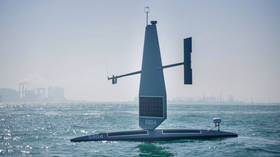US and UK hold drone drills

American and British forces conducted exercises in the Persian Gulf on Friday involving Saildrone Explorer naval drones, the US Navy’s Fifth Fleet has announced.
Two US and two UK warships, as well as three unmanned surface vehicles (USVs), took part in the one-day exercises, which were held off the coast of Bahrain.
As part of the drills, the USVs captured still images of training targets and forwarded them to both the vessels and to the Fifth Fleet’s command center in Bahrain. The photos were then analyzed by artificial intelligence, commander Timothy Hawkins, a spokesman for the Fifth Fleet, told AP.
Vice Admiral Brad Cooper, commander of the US Naval Forces Central Command, US Fifth Fleet and Combined Maritime Forces, hailed the results of the exercise, saying that “we have already achieved more today than many might have imagined possible when we started.”
“Our goal is a distributed and integrated network of systems operated with our partners to significantly expand how far we can see,” Cooper added.
The commercially available Saildrone Explorer drones are wind- and solar-powered and can stay at sea for long periods. That makes them particularly attractive for the US Navy in monitoring the 8,000 kilometer (5,000 miles) coastline stretching from the Suez Canal, through the Red Sea into the Gulf of Oman and into the Persian Gulf.
“No matter what forces you have, you can’t cover all that. You have to do that in a partnered way and an innovative way,” Timothy Hawkins pointed out.
Iran, which views the activities of the US Navy near its shores as a security threat, briefly captured two Saildrone Explorer USVs in the Red Sea in early September and another in the Persian Gulf in August. On both occasions the drones were released as soon as an American warship arrived in the area.
AP also cited a notice issued by the US Navy this week, warning that it will continue to “lawfully operate in international waters and through straits in accordance with internationally recognized rights and freedoms” and that any interference with hardware “will be considered a violation of the norms of international maritime law.”














